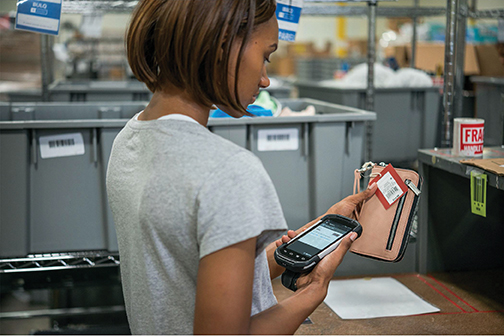Creating Value from Returns this Holiday Season
By Ken Lim, Optoro
Returns can often be viewed as an unfortunate cost of doing business. But they don’t have to be. Retailers can recoup lost profits and drive growth this holiday season by viewing returns as an opportunity and optimizing returns strategies.
Optoro estimates that returns cost retailers $400B each year in the US alone.1 And during the holiday season, retailers can expect returns to skyrocket with over 66% of consumers reporting that they returned at least one gift this past year.2 Determining what to do with a large volume of returned products is a complex process, and many retailers rely on manual, rule-based decision-making and inefficient processing, which can lead to a significant amount of waste.
Using returns technology automates the returns routing process by leveraging data-driven decision-making that sends returned inventory to the most profitable channel. This ensures that the most value is recovered from each return, increasing topline growth, reducing operational costs and decreasing environmental waste.
Grow Topline Revenue
As a result of the COVID-19 pandemic this year, many consumers were forced to do the majority of their shopping online. In fact, emarketer estimates that US consumers will spend $709.78 billion on ecommerce in 2020, representing an increase of 18%.3 And with higher ecommerce spending, we might expect higher rates of returns. By some estimates, ecommerce returns rates can be three times higher than brick and mortar rates, leaving retailers with a potential 30% return rate on their ecommerce orders.4
Give Customers an Easy Way to Return
Now more than ever, retailers should adopt online returns processes that allow them to recover the most value from returned items. This starts with a customer-facing portal that allows shoppers to initiate their return online, and seamlessly exchange the item rather than just return it. By offering an instant credit for shoppers making a return, retailers can convert three times more returns into repurchases, as compared to portal-less returns.5
Using an online returns portal can also increase customer satisfaction, as 54% of consumers reported that an online portal made their returns process easier.6 And what’s more, 96% of consumers will continue to return to purchase from a retailer who provides a customer-friendly return process.7
Offer Flexible Returns Policies
Another way that retailers can ensure that their returns process encourages repeat customers is by offering flexible returns policies. We’ve seen that 67% of consumers check the returns policy before they even make a purchase.8 Due to COVID-19 store closures, many retailers reevaluated their returns policies to allow for more flexibility by extending the time windows customers have to return items. And this May, we conducted a survey of US consumers, and found that one third of shoppers had even made a purchase as a result of extended return time frames.9
A flexible returns policy should also include convenient ways for consumers to send items back. If a retailer has a brick and mortar store (and that store is open), they should accept returns from online orders. And for consumers who choose to return items via mail (or are forced to due to store closures), retailers should also create additional convenience by offering free returns shipping and including a pre-printed label in the box. Free shipping will cost retailers more up-front, but the impact it can have on driving repeat customers will pay off in the long run.
All of these improvements to the returns initiation process can help drive more repeat customers - and more repeat purchases!

Reduce Operational Costs and Increase Recovery
The second phase of a return’s journey—processing the return once the retailer receives it—is also an important area for retailers to create more value.
Technology to Improve Recovery on Returns
Historically, many retailers have used manual and subjective decision-making processes when determining where to route returns after they are received. But with the complexity involved, this can lead to a lot of challenges for store and warehouse associates. Returned products can come back in a variety of conditions. Sometimes a return includes a return authorization (“RA” or “RMA”), but other times it does not. And even if the item does have a return authorization, what’s inside the box might not match what’s on the return authorization. There are also other factors to consider like the item’s seasonality. What do you do if a winter parka gets returned in July?
To better manage this complexity, retailers should consider replacing manual processes with technology that optimally routes inventory to available channels based on attributes such as price, condition, seasonality, SKU depth and other key factors. By automating these processes, items can be quickly routed to the most profitable channel, ensuring that the most value is recovered on each return. This can include routing an item back to stock, to a charity or to a secondary marketplace like Amazon or eBay, or a retailer’s own proprietary marketplace. And this holiday season, there is increased value in being able to automatically route inventory to an online marketplace rather than physical outlets which run the risk of being shut down due to COVID-19 closures.
Increasing Operational Efficiency
A speedy disposition also frees up valuable warehouse space, allows associates to focus more on forward orders, and cuts down on unnecessary shipments and touches that can become costly. We’ve calculated that there are 10B + needless shipments and touches throughout the retail industry as returns are sent from stores to distribution center after distribution center.10 Efficient returns routing can also speed up inventory flow and reduce the amount of out-of-stock items, which decreases the chances that customers will become frustrated by their chosen product being sold out.
And this holiday season, retailers’ warehouses will potentially face continued social distancing measures that require decreased warehouse labor due to occupancy limitations. Using technology to assist with returns processing allows retailers to make up for limited labor forces with increased efficiency.
All of these efficiency improvements can add up to significant cost savings, while protecting employee health.

Decrease Environmental Waste
In addition to improving the customer experience and reducing the financial loss that returns can otherwise cause, returns technology also decreases negative environmental impacts.
Retailers are facing mounting pressure to adopt more sustainable business habits, and many are announcing initiatives to become circular organizations. To achieve true circularity, retailers will need to start optimizing their reverse logistics programs. Some leading retailers have already begun doing this. IKEA, for example, recently partnered with Optoro to help achieve their goal of becoming circular by 2030 through eliminating waste in the supply chain.11
Returns technology can have a big impact on reducing environmental waste, by helping to divert items from landfills, and instead routing them to resale channels, charities or recyclers. In fact, by tapping into a network of donation partners and recyclers, as well as by implementing remarketing solutions, Optoro’s clients typically reduce the amount of product sent to landfill by more than 30%.12
It also allows retailers to prevent unnecessary carbon emissions by reducing the number of steps in the reverse supply chain, sending returned products directly to their next best homes. Retailers that use returns technology typically reduce the carbon emissions resulting from their reverse supply chains by more than 20%.13
Beyond contributing to companies’ environmental goals, embracing circular business practices can help with customer acquisition. According to Sustainable Brands, over 50% of consumers have boycotted a company for having business practices they view as irresponsible.14 With the holiday season serving as a critical moment for customer acquisition and retention, retailers should be careful not to lose customers this year due to unsustainable returns practices.
Conclusion
On top of the typical strain holiday returns can put on retailers’ supply chains, this year we’ll be facing additional challenges caused by the COVID-19 pandemic. Understanding that product returns are an opportunity to grow revenue by driving customer loyalty and repeat purchases, rather than reduce it, can give retailers a real competitive advantage this holiday season. Whether a retailer is looking for ways to increase recovery on their returned items, reduce operational costs, or improve their environmental impacts (or all three!), investing in returns technology and/or optimizing their returns strategy is a clear place to begin.
References
1 Optoro and NRF projection
2 Optoro survey of 1380 consumers from January 31, 2020 to February 3, 2020.
3 US Ecommerce 2020. Emarketer, 2020. https://www.emarketer.com/content/us-ecommerce-2020.
4 Ecommerce Product Return Rate. Invesp. https://www.invespcro.com/blog/ecommerce-product-return-rate-statistics/
5 Optoro and Returnly Client Performance Data & Analytics, 2019/2020
6 Optoro survey of 1000 consumers from November 12 to November 15, 2019.
7 Retail Returns and the Customer Experience. Optoro, 2018.
8 Ecommerce Product Return Rate. Invesp. https://www.invespcro.com/blog/ecommerce-product-return-rate-statistics/
9 Optoro survey of 2039 consumers from May 8, 2020 to May 11, 2020.
10 Optoro analysis informed by Hoovers, NRF, US Census
11 IKEA Retail US Partners with Optoro to Reduce Waste from Returns. IKEA, 2020. https://www.ikea.com/us/en/this-is-ikea/newsroom/ikea-retail-u-s-partners-with-optoro-to-reduce-waste-from-returns-pub627f9f50
12 Optoro environmental impact models of downstream value chains, developed in collaboration with Environmental Capital Group. Weighted average results from client programs, full year 2019.
13 Optoro environmental impact models of downstream value chains, developed in collaboration with Environmental Capital Group. Weighted average results from client programs, full year 2019.
14 New Report Reveals 86% of US Consumers Expect Companies to Act on Social, Environmental Issues. Sustainable Brands, 2018. https://sustainablebrands.com/read/marketing-and-comms/new-report-reveals-86-of-us-consumers-expect-companies-to-act-on-social-environmental-issues
 Ken Lim
Ken LimFrom conference calls with Fortune 500 retailers to working taco lunches with refurbishment technicians at warehouses south-of-the-border, Ken has seen many layers and partnerships in reverse logistics, and he leads our Client Development team to bring winning reverse logistics solutions to our clients.
Prior to Optoro, he spent six years at another reverse logistics company where he was responsible for an account portfolio of over $100M per year in addition to designing and managing more than $10M-worth of in-house and outsourced electronics refurbishment. He began his early supply chain career at CEB’s Operations practice.
Ken received his B.S. in Civil Engineering from Stanford University and his M.B.A. from Georgetown University. He traces his passion for the ways that business can support environmental responsibility to his time as a Peace Corps volunteer in Jamaica and continues to support that work as the vice-chair of the non-profit Friends of Jamaica.